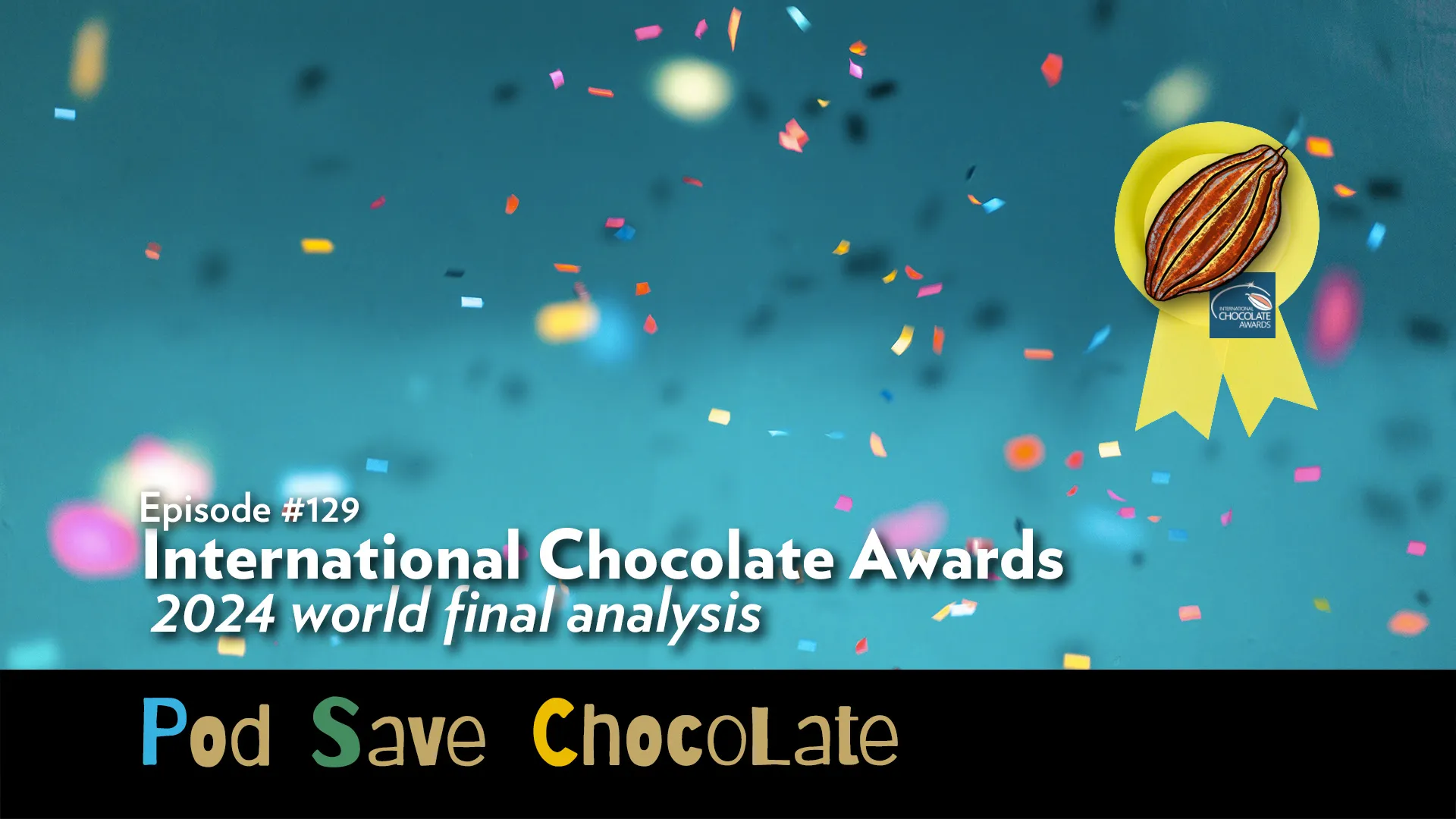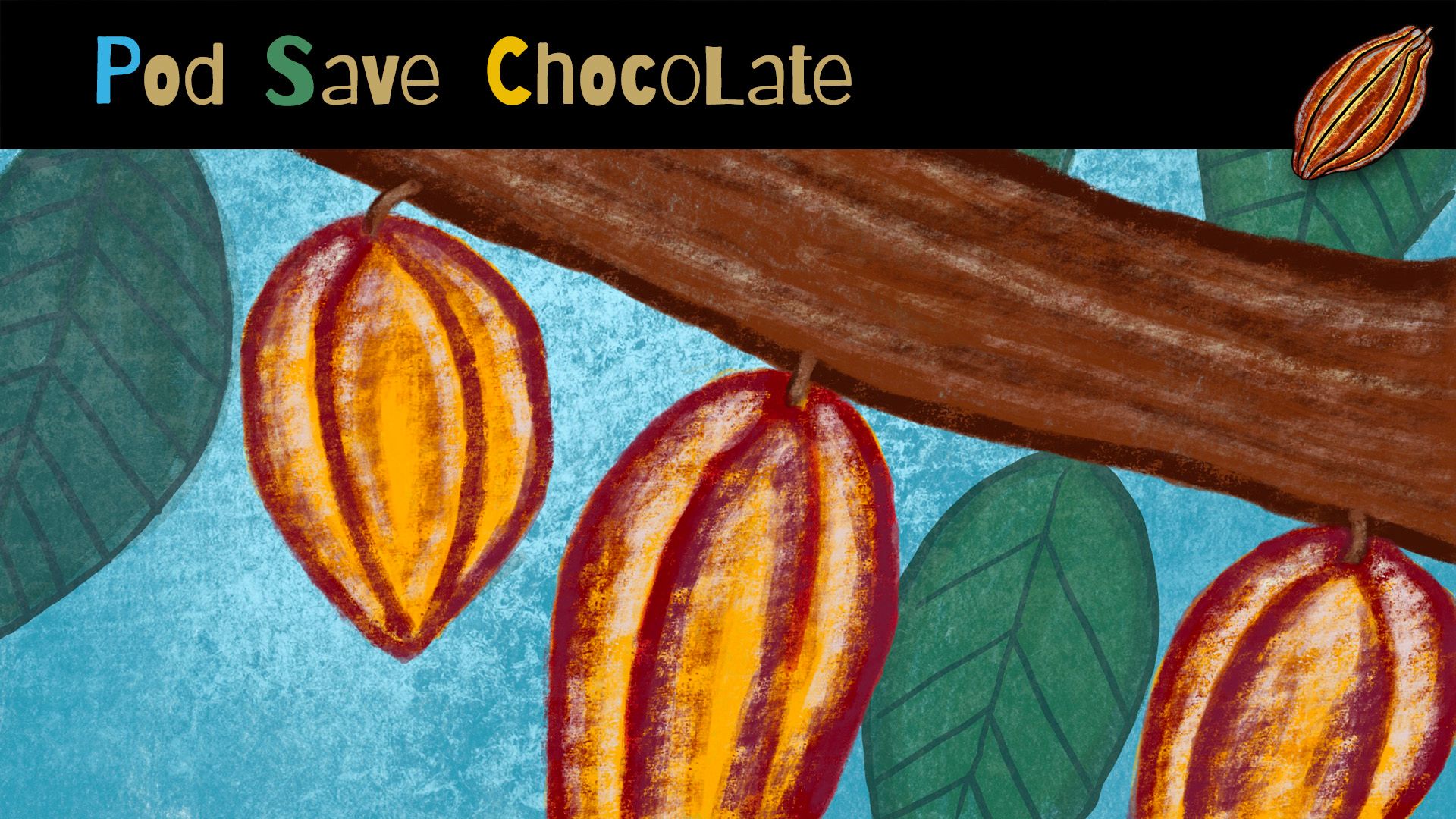Deep Dive: International Chocolate Awards 2024 World Final | #PodSaveChocolate Ep 129

Episode 129 takes a deep dive look at the Winners in the 2024 World Final round of the International Chocolate Awards. Which company was the biggest winner? What can we learn about the distribution of winning entries? And more. [Updated]
When and Where to Watch
Links below to watch LIVE and to view the archived episode.
Click on this (shareable) link to watch on YouTube. Please subscribe (free!) to the @PodSaveChocolate YouTube channel, like this video, comment, and share this episode to help grow the #PSC community.
Watch and comment LIVE or view the archived episode on LinkedIn. Join my network on LinkedIn to receive notifications and to refer business to each other.
Watch and comment LIVE or view the archived episode on TheChocolateLife page on Facebook (for 30 days, then watch the archive on YouTube).
Follow TheChocolateLife on Facebook to receive notifications and catch up on other content.
Episode 129 Overview
In this episode of PodSaveChocolate, I will be taking a Deep Dive look at the winners of the 2024 World Final Round of the International Chocolate Awards.
The 2024 World Final Winners ⋯
In past years, this has been a laborious and painstaking process as it requires huge amounts of effort to scrape the page, decode the structure, reorganize the data, extract key elements (without copypasta errors), and then run analyses in a spreadsheet. Doing this work for previous years’ awards has taken me at least five hours per edition/round, even using some non-spreadsheet text and data manipulation tools and techniques.
Based on my experience using Google Gemini and Dia to manipulate and grab data presented in Episode 128, I decided to see what Gemini and Dia could do to speed the process up.
The time savings are truly remarkable. I was able to accomplish in under 30 minutes of active time what took me at least 10x longer to do manually. I used Gemini to do the data gathering, organization, and analysis. I used Dia to write regex code that would enable me to clean up some of the results in a programmer’s text editor (I use Sublime).
Furthermore, I was able to ask Gemini to make some comparisons that would have been even more tediously painstaking to do by hand.
One of those tasks was to generate a list of all of the Grand Jury Finalists (entries, not companies) in the 2024 World Final that did not win awards.
Similarly, I asked Gemini to generate a list of winners that were common to both the 2024 ICA World Finals round and the 2024 Academy of Chocolate (AoC) Awards, as well as generate a list of Winners in the AoC awards that were not winners in the ICAs.
Why? (Part 1)
The world of specialty/craft/bean-to-bar chocolate is woefully self-aware. The more we know about this segment of the market, the better job we can to market what makes specialty/craft/bean-to-bar different from (and better than) industrial chocolate.
No one knows how many makers there are, where they are, how much cocoa they purchase, or the value of the products they sell.
While this work does not begin to address those questions, it does give us insight into companies whose work is highly valued by important players in the market and the products those companies make. By extending this work over many years (and markets), we get a view of how the market has evolved.
Yes, it is a self-selected view limited to those companies that enter awards, but that does not mean we can’t learn from some of the meta-analyses.
Why? (Part 2)
Another reason is that I get to learn cool trivia ⋯ what my father used to call “Very important facts not worth knowing.” One thing I learned doing this work was the meaning of the word “boero” which was one of the special distinction awards in the ICAs. It refers to a “large chocolate filled with liqueur and a cherry in alcohol.” Or, as we might call this here in the US, a cherry cordial. I saw these being made by hand at Romeo Viganotti in Genoa in 2017-ish, but I did not catch their Italian name.
Top-Level Analyses
Which companies won what awards, and how many?
118 different companies won awards.
How many Grand Jury Finalist entries won awards?
107 Grand Jury Finalist entries did not win awards; 235 Gold. Silver, and Bronze awards were given: 55% of GJF entries won primary awards.
How were the awards distributed by country?
• Europe: 36 companies won awards
• Asia: 29 companies
• North America (Canada, US, Mexico, Caribbean): 25 companies
• South America: 18 companies
• All other regions: 10 companies
How were the awards distributed by category?
• 42 awards in “Micro-batch – Plain/origin dark chocolate bars”
• 40 awards in “Dark chocolate bars with an infusion or flavouring”
• 21 awards in “Plain/origin dark chocolate bars”
• 20 or fewer awards in all other categories.
What about all those Special Awards? How many are there? How many of each were given out?
There were more than 60 mentions across more than 20 different Special Distinction categories
How many companies won awards in BOTH the 2024 International Chocolate World Final AND the 2024 Academy of Chocolate Awards?
11 companies appear on both Winners lists.
How many companies were given awards by the Academy and were not recognized in the ICAs?
About 100. The precise number will take more work to determine because of inconsistent spellings e.g., KESSHO, KESSHŌ, and KESSHŌ珂珂琥 are the same company. They need to be counted once, not three times.
Winners Summary
Friis-Holm Chokolade (Denmark) stands out as the most decorated participant, with 18 awards (over 6% of all medals awarded). The company's success is notable for its breadth, with four Gold, six Silver, and eight Bronze medals across plain bars, flavored bars, and filled chocolate categories.
Following closely are:
- Fu Wan Chocolate (Taiwan) earned 15 awards, primarily in the flavored and micro-batch bar categories.
- Goodnow Farms Chocolate (USA) took home 11 awards, demonstrating versatility with wins in flavored, alternative-ingredient, and white chocolate bars.
- Italian confectioners also feature prominently, with Guido Castagna and Bellantoni Cioccolato winning 9 and 7 awards respectively, dominating the praline, cremino, and spread categories.
The TL;DR
The top 10 most awarded companies (winning 6+ awards each) took home a total of 87 medals between them, more than one-third of all medals awarded.
This concentration may indicate that while the broader ICA winner universe is diverse, it is anchored in a relatively small number of makers who consistently meet judges’ expectations for quality and innovation.
OTOH, it might indicate that a small number of makers who enter a lot of bars in a lot of categories (thereby increasing their overall chances of winning) skews the results.
Also, historically, that group of most-awarded makers has changed as the industry and the competition itself have evolved (consider Paccari/Pacari).
Geographic Summary
- The United States was home to makers who won 45 medals, reflecting a large, mature, specialty chocolate scene.
- Italy followed with 33 awards, based on its history and mastery of nut-based products – gianduias, creminos, and dragées.
- Japan (21 awards) and Canada (20 awards) also demonstrated strength.
- Entrants from Japan notably achieved well in the ganache categories.
- Canadian makers fared well in the flavored bars and micro-batch categories.
- The increase in the number of Producing Countries (countries where cocoa is grown and the finished product is manufactured) as production powerhouses continues to be a significant trend.
- Peru (18 awards)
- Taiwan (18 awards), a historically new Producing Country, has firmly established itself as a source for sophisticated flavored products.
- Thailand (9 awards),
- Venezuela and Ecuador (5 awards each)
- Colombia (4 awards)
- This displays a continuing shift in the value chain, with expertise and innovation thriving in Producing Countries.
TL;DR
The geographic spread of winners confirms the globalized market for specialty chocolate products. While Europe and North America remain strongholds, their dominance is being challenged by producers other regions.
Cacao Percentage Summary
- The 70-79% Sweet Spot: The vast majority of winning dark chocolate bars fell within the 70-79% cacao range. This range offers a balance between expressing the nuances of the cacao’s potential while maintaining accessibility to a broad audience. Over 80 winning products were in this range.
- High-Percentage Frontier (80%+): There were 15 awards for bars at 85% or higher, including five for 100% cacao bars. This demonstrates a strong and growing interest in intense, unadulterated experiences where the cacao shines through..
- The 60-69% Borderlands: With over 30 awards, this category is a frontier for innovation, allowing for more prominent flavor notes from inclusions, infusions, or the milk itself, not just the chocolate.
- Milk & White Chocolate (Below 60%):
- Winning milk chocolates typically featured cacao percentages between 40% and 58% (far higher than industrial options), often marketed as “dark milk.”
- Winning white chocolates showed that innovation in flavorings and inclusions, not percentages, is the key to success in this category.
Prior Livestreams Related To This Topic




Questions?
If you have questions or want to comment, you can do so during the episode or, if you are a ChocolateLife member, you can add them in the Comments below at any time.
Episode Hashtags and Socials
#DeepDive
International Chocolate Awards on Instagram
Academy of Chocolate Awards on Instagram
#cocoa #cacao #cacau
#chocolate #chocolat #craftchocolate
#PodSaveChoc #PSC
#LaVidaCocoa #TheChocolateLife
Future Episodes
#PodSaveChocolate and #TheChocolateLifeLIVE Archives
To read an archived post and find the links to watch archived episodes, click on one of the bookmark cards below.

Episodes 101+ (link to the first 100 episodes archive in this post)

Archive of all episodes — 1-129.

Link to the posts for each of the 29 weeks of Clubhouse. Each post contains an index of the topics covered. Some posts have links to episode audio.

Audio-only podcasts









